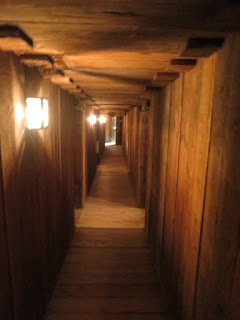The name Flanders Fields is particularly associated with battlefields in an area straddling the Belgium Provinces of West Flanders and East Flanders as well as an area known as French Flanders. Over a period of three and a half years, hundreds of thousands of soldiers from fifty nations and five continents died here.
Our first stop was at the Passchendaele Museum.
The battle of Passchendaele in 1917 was one of the biggest and bloodiest encounters of the Great War. In 100 days of heavy fighting 245,000 British, Australian, Canadian, New Zealand and South African soldiers were killed or wounded to gain just 5 miles.
In the museum there were artifacts from the battlefield including uniforms, medical instruments, and objects illustrating day-to-day life at the front. One exhibit explains--and let's you sniff--the 4 basic types of poison gas used here.We were also able to go down in a simulated network of wooden underground "dug out" tunnels used by British forces as their headquarters, after the ground level was so scorched by the artillery that nothing was left up above.
We then drove to Tyne Cot Cemetery nearby where 11,956 British Commonwealth soldiers are buried.
This cemetery was beautifully planted with roses and seasonal flowers and so very well maintained.
We had a quick lunch of grilled cheese sandwich and a Belgium beer, of course.
Upon leaving, we saw a guy in the parking lot in an old Bentley.
Several people crowed around to check it out and take pictures. It really was something to see.
After a thirty mile drive we arrived at Waregem where the only American WWI cemetery in Belgium is located.
Four hundred eleven American servicemen are buried or commemorated here.
Many of them fell at Spitaals Bosschen, an action of the Ypres-Lys Campaign by the 91st Infantry Division in the closing days of the war.
The headstones are arranged in four symmetrical areas around the white chapel that stands in the center of the cemetery.
After viewing these battlefields we are reminded of the poem by John McCrae. On May 3, 1915 Canadian physician Lieutenant-Colonel John McCrae, inspired after presiding over the funeral of a friend and fellow soldier, sat down in the back of an ambulance and wrote "In Flanders Fields".




























No comments:
Post a Comment